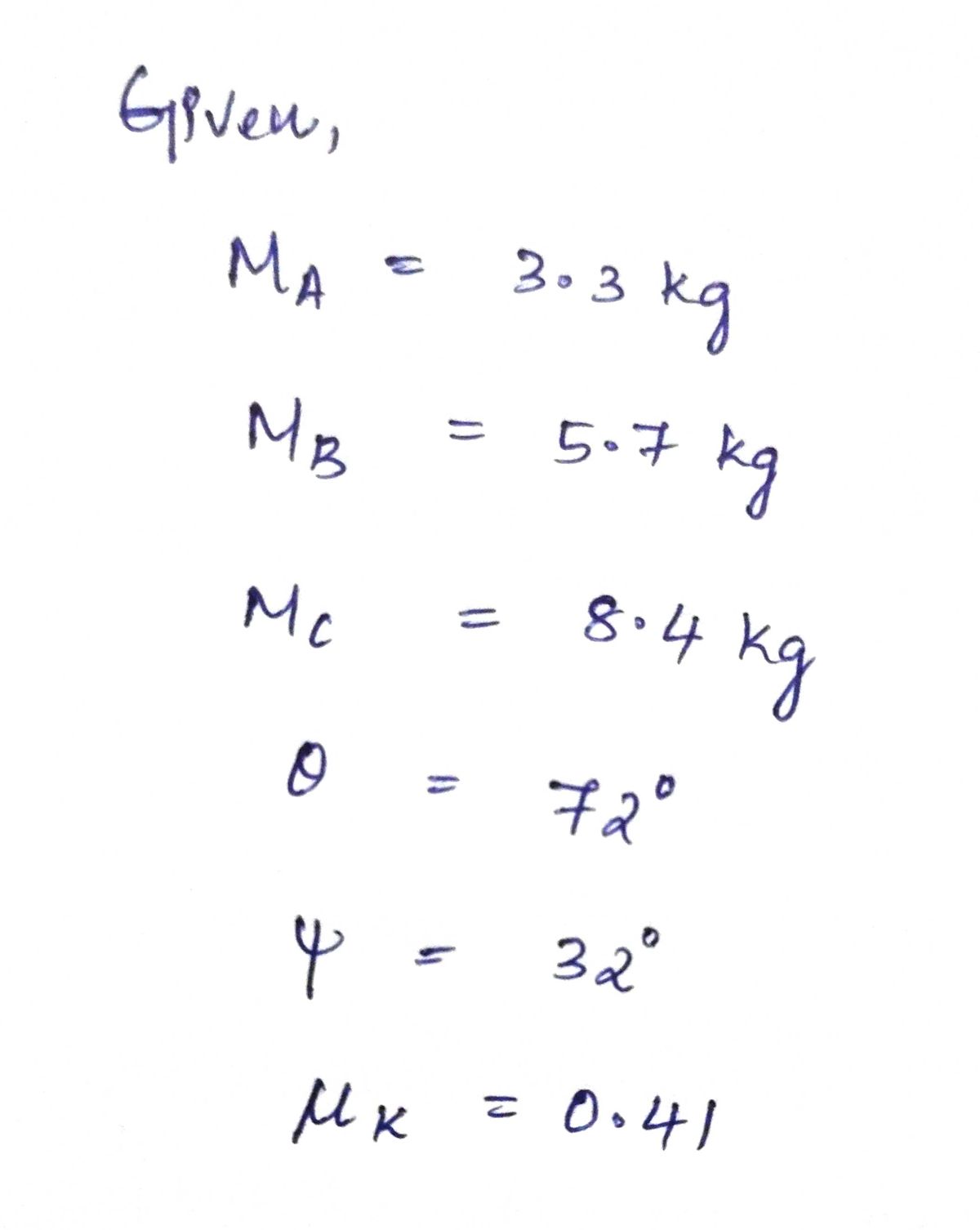This question refers to the situation in Figure 2, above. The mass of block A is 3.3 kg. The mass of cart B is 5.7 kg. The mass of cart C is 8.4 kg. The plane under block B is inclined at an angle theta = 0 = 72 degrees away from vertical. The plane under cart C is inclined at an angle phi = p = 32 away from vertical. The coefficient of kinetic friction between block B and the plane beneath it is 0.41. The blocks are all moving. The velocity of Block A points downward, and none of the strings stretch. Assume the only significant forces in this situation are tension forces, normal forces, friction only between block B and the plane beneath it, and gravity with g = 9.81 m/s?. Calculate the acceleration of block A, in units of meters per second squared. The sign, positive or negative, of your answer is important and for this problem a positive acceleration points downward for block
This question refers to the situation in Figure 2, above. The mass of block A is 3.3 kg. The mass of cart B is 5.7 kg. The mass of cart C is 8.4 kg. The plane under block B is inclined at an angle theta = 0 = 72 degrees away from vertical. The plane under cart C is inclined at an angle phi = p = 32 away from vertical. The coefficient of kinetic friction between block B and the plane beneath it is 0.41. The blocks are all moving. The velocity of Block A points downward, and none of the strings stretch. Assume the only significant forces in this situation are tension forces, normal forces, friction only between block B and the plane beneath it, and gravity with g = 9.81 m/s?. Calculate the acceleration of block A, in units of meters per second squared. The sign, positive or negative, of your answer is important and for this problem a positive acceleration points downward for block
Principles of Physics: A Calculus-Based Text
5th Edition
ISBN:9781133104261
Author:Raymond A. Serway, John W. Jewett
Publisher:Raymond A. Serway, John W. Jewett
Chapter4: The Laws Of Motion
Section: Chapter Questions
Problem 3P: A toy rocket engine is securely fastened to a large puck that can glide with negligible friction...
Related questions
Question

Transcribed Image Text:This question refers to the situation in Figure 2, above. The mass of
block A is 3.3 kg. The mass of cart B is 5.7 kg. The mass of cart C is
8.4 kg. The plane under block B is inclined at an angle theta = 0 = 72
degrees away from vertical. The plane under cart C is inclined at an
angle phi = p = 32 away from vertical. The coefficient of kinetic
friction between block B and the plane beneath it is 0.41.
The blocks are all moving. The velocity of Block A points downward,
and none of the strings stretch. Assume the only significant forces in
this situation are tension forces, normal forces, friction only between
block B and the plane beneath it, and gravity with g = 9.81 m/s?.
Calculate the acceleration of block A, in units of meters per second
squared. The sign, positive or negative, of your answer is important
and for this problem a positive acceleration points downward for block
A.

Transcribed Image Text:Figure 2
В
A
Block A is hanging from a massless string which runs over a massless
and frictionless pulley and connects to Block B. Block B slides over an
inclined plane with ordinary kinetic friction. The plane under block B
is inclined at an angle theta = 0 away from vertical. The other side of
Block B is connected to another massless string which runs over
another massless and frictionless pulley to connect to Cart C. Cart C
rolls without friction over a plane which is inclined at an angle of phi =
y away from vertical.
C
Expert Solution
Step 1:: INTRODUCTION

Trending now
This is a popular solution!
Step by step
Solved in 4 steps with 3 images

Knowledge Booster
Learn more about
Need a deep-dive on the concept behind this application? Look no further. Learn more about this topic, physics and related others by exploring similar questions and additional content below.Recommended textbooks for you

Principles of Physics: A Calculus-Based Text
Physics
ISBN:
9781133104261
Author:
Raymond A. Serway, John W. Jewett
Publisher:
Cengage Learning

Principles of Physics: A Calculus-Based Text
Physics
ISBN:
9781133104261
Author:
Raymond A. Serway, John W. Jewett
Publisher:
Cengage Learning